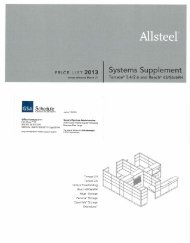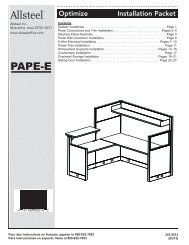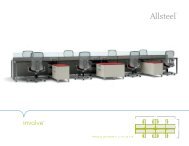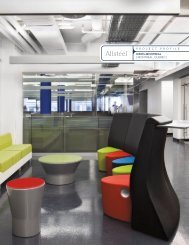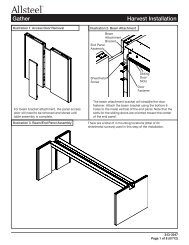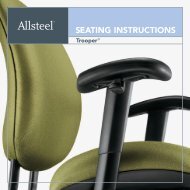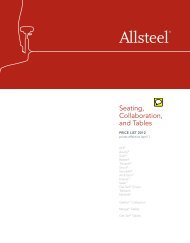The 2008 Workplace Survey - Gensler
The 2008 Workplace Survey - Gensler
The 2008 Workplace Survey - Gensler
Create successful ePaper yourself
Turn your PDF publications into a flip-book with our unique Google optimized e-Paper software.
a Design + Performance Report<br />
<strong>2008</strong><br />
WOrkplace<br />
<strong>Survey</strong><br />
UNITED STATES
contents<br />
Foreword 2<br />
Summary of findings 8<br />
Finding One 10<br />
Success in a knowledge economy<br />
means working differently.<br />
Finding Two 14<br />
Top-performing companies<br />
design their workplaces to support<br />
all four work modes.<br />
Finding Three 22<br />
Effective workplace design<br />
directly correlates with improved<br />
business performance.<br />
continued exploration 32<br />
Methodology 33<br />
End notes 34
foreword<br />
Today, business success flows from intangible assets such<br />
as ideas, information, and expertise. Post-industrial metrics<br />
fall short of offering the insights that companies need to<br />
gain a competitive edge in a global business environment<br />
that values these kinds of assets.<br />
<strong>Gensler</strong>’s research establishes new measures of performance<br />
that make the difference in a knowledge economy: the power<br />
of people and place to drive profit.<br />
As the leading design firm for business, <strong>Gensler</strong> has a unique<br />
perspective on the ways that people really work. Through<br />
projects with thousands of companies and our annual<br />
workplace surveys, we have seen firsthand the revolution<br />
of knowledge work, and how individuals and teams create<br />
organizational value and drive performance.<br />
<strong>The</strong> <strong>2008</strong> <strong>Gensler</strong> <strong>Workplace</strong> <strong>Survey</strong> creates new insight<br />
about the day-to-day knowledge workplace activities<br />
that produce business success: four work modes—focus,<br />
collaborate, learn, and socialize—that allow the creative<br />
and innovative power of people to be fully realized.<br />
<strong>Gensler</strong>’s <strong>Workplace</strong> Performance Index SM measurement<br />
and analysis tool for work environments correlates<br />
business success with the effective support of the four work<br />
modes in the workplace.<br />
2 <strong>Gensler</strong> <strong>2008</strong> <strong>Workplace</strong> <strong>Survey</strong> / United States <strong>Gensler</strong> <strong>2008</strong> <strong>Workplace</strong> <strong>Survey</strong> / United States 3
KNOWLEDGE<br />
WORK equals<br />
FOUR WORK MODES<br />
work interactions that create<br />
common bonds and values,<br />
collective identity, collegiality<br />
and productive relationships<br />
talking, laughing, networking,<br />
trust-building, recognition,<br />
celebrating, interacting,<br />
mentoring, enhancing relationships<br />
<strong>Gensler</strong> research shows that people spend an<br />
average of 6% of their time in social activities.<br />
focus<br />
productive capital<br />
work involving concentration<br />
and attention to a particular<br />
task or project<br />
thinking, reflecting, analyzing,<br />
writing, problem-solving,<br />
quantitative analysis, creating,<br />
imagining, reviewing, assessing<br />
<strong>Gensler</strong> research shows that people spend on<br />
average 48% of their time in focus work.<br />
socialize<br />
social capital<br />
collaborate<br />
innovative capital<br />
working to acquire new<br />
knowledge of a subject or skill<br />
through education or experience<br />
training, concept exploration<br />
and development, problemsolving,<br />
memorizing, discovery,<br />
teaching, reflecting, integrating<br />
and applying knowledge<br />
<strong>Gensler</strong> research shows that people spend an<br />
average of 6% of their time learning.<br />
learn<br />
Intellectual capital<br />
working with another person or<br />
group to achieve a goal<br />
sharing knowledge and information,<br />
discussing, listening, co-creating,<br />
showing, brainstorming<br />
Interactions may be face-to-face,<br />
by phone, video, or through virtual<br />
communication<br />
<strong>Gensler</strong> research shows that across all companies,<br />
people spend an average of 32% of their time<br />
collaborating.<br />
4 <strong>Gensler</strong> <strong>2008</strong> <strong>Workplace</strong> <strong>Survey</strong> / United States <strong>Gensler</strong> <strong>2008</strong> <strong>Workplace</strong> <strong>Survey</strong> / United States 5
KNOWLEDGE WORK equals<br />
FOUR WORK MODES<br />
“Knowledge worker,” a term popularized by management<br />
expert Peter Drucker, refers to an individual<br />
who develops and applies knowledge and information<br />
in the workplace. It is now estimated that knowledge<br />
workers outnumber all other workers in North<br />
America by at least four to one.<br />
While industrial era companies were focused on<br />
task processes and tools to improve speed, efficiency,<br />
and productivity, knowledge economy companies<br />
realize competitive advantage through the creation<br />
of ideas. Knowledge work requires a high level of<br />
cognitive involvement as well as analytical and<br />
judgment skills; process remains important but<br />
is far less structured. Knowledge work is also<br />
a composite of individual and collective modes.<br />
<strong>The</strong> overview of work modes below codifies these<br />
practices in the new science of work.<br />
FOCUS<br />
collaborate<br />
learn<br />
socialize<br />
Research bears out the value that companies can realize by enabling<br />
their employees to focus better. Separate studies conducted<br />
at MIT and Harvard show that interruptions and distractions are<br />
among the biggest threats to worker concentration. Cognitive<br />
overload—the inability to concentrate due to excessive information—poses<br />
another barrier to productivity. 1<br />
People can make leaps in productive focus if they are granted<br />
distraction-free, protected time to get their individual work done.<br />
Yet while research shows increasing organizational support for<br />
the valuable interactive aspects of knowledge work, the support<br />
may have come at the expense of the individual aspect. 2<br />
<strong>The</strong>se other work modes, as well as modern pressures on real estate<br />
costs, have diminished the quality of the focus mode. Collaboration<br />
and socializing have encroached on focus work by undermining the<br />
ability of the traditional site of focus work—the primary work space—<br />
to support concentrated individual activity due to distraction as<br />
colleagues gather to collaborate or socialize.<br />
Open work environments help to foster interaction and also reduce<br />
real estate footprint, but can also result in the acoustical and<br />
visual distractions that hamper people’s ability to focus. This and<br />
other factors pose a dilemma for organizations looking to balance<br />
focus with other work modes.<br />
Innovation, speed and economic value in a knowledge economy<br />
are derived more and more from “collective intelligence”—the<br />
open sharing, connecting and building on ideas through a group<br />
process. Teams have the potential to offer greater breadth and<br />
creativity than any one individual can offer, resulting in innovative<br />
and comprehensive solutions and ideas. 3<br />
Teamwork exists in many different shapes and forms, and varies<br />
across important dimensions. Teams require the ability to interact<br />
with each other to achieve objectives through a shared understanding<br />
of resources, such as members’ knowledge, skills, and experiences,<br />
and explicit goals and objectives. Research shows that effective<br />
teamwork also involves interactions with tasks, tools, and machines. 4<br />
Knowledge creation is another important outcome of collaboration.<br />
Research at MIT found that people were five times more likely<br />
to turn to another individual for information than to search a nonhuman<br />
source such as a file or database, pointing to the value of<br />
interactive work as a business asset. It is estimated that over 70%<br />
of what people know about their jobs is gained through everyday<br />
interactions with their colleagues. 5, 6<br />
Research has definitively linked environments characterized by<br />
visibility, openness, and greater worker mobility to effective<br />
collaboration. Proximity and visual contact help people interact<br />
frequently and build relationships that help them share information,<br />
think creatively, and reach more innovative solutions. This<br />
was echoed in <strong>Gensler</strong>’s 2006 workplace survey that correlated<br />
collaboration with innovation. 7<br />
Knowledge economy companies are increasingly aware that the<br />
success of their people is determined by not just what they know<br />
but how fast they can learn and share their learning. <strong>The</strong> American<br />
Society for Training and Development found that U.S. organizations<br />
spent $109.25 billion annually on employee learning and development,<br />
with roughly 75% of that spent on internal learning programs.<br />
ASTD’s figures also show that the outsourcing of learning is on<br />
the decline, while investment in proprietary learning technologies<br />
is growing. 8<br />
Learning must be integrated into all aspects of a job because<br />
of the constant demands of change and the need for increasingly<br />
skilled workers, which traditional education cannot rapidly supply.<br />
In addition, companies want to avoid down-time while an<br />
employee trains. For all these reasons, there is tremendous<br />
pressure for workplaces to integrate learning with every aspect<br />
of daily activity. 9<br />
<strong>The</strong> design, development and facilitation of learning at work<br />
requires careful consideration of the context of learning as well<br />
as the learning styles of participants. Researchers have identified<br />
multiple ways adults learn. 10 Each learning style has different<br />
implications for when, how and where learning takes place, and<br />
suggests variations in the physical environments required<br />
to support them, challenging organizations to create not just<br />
discrete spaces where people learn, but entire workplaces that<br />
support varied employee needs.<br />
Structured learners<br />
Prefer teacher-directed, highly structured programs with explicit<br />
assignments that are assessed by the instructor; lectures and tutorials<br />
Collaborative learners<br />
Discussion-oriented with a preference for group projects, collaborative<br />
assignments and social interaction; role playing<br />
In today’s knowledge economy, the flow of information between<br />
and among people is at a premium. <strong>The</strong> sense of community<br />
developed through building a social collective creates the<br />
pathways of information sharing and establishes the common<br />
values, culture and mission of an organization.<br />
A 2001 report on the changing nature of work by the National<br />
Research Council called attention to the importance of the<br />
relational and interactive aspects of work, 11 while researchers Cross<br />
and Prusak concluded that knowledge economy success will be<br />
increasingly social and relational, with work accomplished through<br />
informal networks more than organizational hierarchies. 12<br />
Social capital refers to the value of the connections among<br />
individuals in a social network and the norms of reciprocity and<br />
trust that arise from these groups. It contributes value by creating<br />
knowledge and new organizational resources that enhance the<br />
potential for individual and collaborative action.<br />
Trust is an essential component of social capital. <strong>The</strong> greater<br />
the level of trust within a community, the greater the likelihood<br />
of cooperation. Similarly, mutually-held values and shared beliefs<br />
are fundamental to the process of collaborative action, and are<br />
closely tied to the flow of information in networks. 13 Social capital<br />
facilitates people’s ability to act on these beliefs and expectations.<br />
Social networks help organizations to solve problems, learn, innovate,<br />
and adapt. <strong>The</strong>y have been cited by researchers as an organizational<br />
advantage because of their capacity to produce new<br />
knowledge. Research has also shown that the differences between<br />
firms, including differences in performance, may stem from<br />
differences in their ability to create and effectively operate as a<br />
social collective. Firms that develop a robust social infrastructure<br />
are likely to be more successful. 14<br />
Independent learners<br />
Prefer to influence the content and structure of individually-directed<br />
learning programs; distance learning, computer or web-based learning<br />
Note: Research references begin on page 36.<br />
6 <strong>Gensler</strong> <strong>2008</strong> <strong>Workplace</strong> <strong>Survey</strong> / United States <strong>Gensler</strong> <strong>2008</strong> <strong>Workplace</strong> <strong>Survey</strong> / United States 7
summary of findings<br />
<strong>Gensler</strong>’s <strong>2008</strong> <strong>Workplace</strong> <strong>Survey</strong> shows that the physical work<br />
environment is an asset with a spe cific and quantifiable impact on<br />
business success. <strong>The</strong> results showed that top-performing companies—<br />
those with higher profits, better em ployee engagement and stronger<br />
market and brand position—have significantly higher-performing<br />
work environments than average co mpanies.<br />
FINDING ONE:<br />
SUCCESS IN A KNOWLEDGE<br />
ECONOMY MEANS WORKING<br />
DIFFERENTLY.<br />
Through our projects with thousands of different<br />
companies, <strong>Gensler</strong> has established a key connecting<br />
point for all knowledge economy companies. Four<br />
work modes—focus, collaborate, learn and socialize—<br />
are the shared language of knowledge economy workplaces,<br />
and are central to our <strong>2008</strong> survey research.<br />
We found that employees at top-performing companies<br />
not only spend more time collaborating and learning,<br />
they consider that time more critical to job success<br />
than do their peers at average companies, who remain<br />
focus work-centered.<br />
FINDING TWO:<br />
TOP-PERFORMING COMPANIES<br />
DESIGN THEIR WORKPLACES TO<br />
SUPPORT ALL FOUR WORK MODES.<br />
Our findings clearly show that top-performing companies<br />
design more effective workplaces that allow people to<br />
spend higher-quality time in the work modes that matter<br />
most to their job success. We analyzed how effectively<br />
various work spaces support the work modes and found<br />
that there is a dramatic opportunity for companies<br />
to leverage workspace improvements that unleash the<br />
potential of their employees and their organization.<br />
FINDING THREE:<br />
EFFECTIVE WORKPLACE DESIGN<br />
DIRECTLY CORRELATES TO IMPROVED<br />
BUSINESS PERFORMANCE.<br />
<strong>Gensler</strong>’s <strong>2008</strong> <strong>Workplace</strong> <strong>Survey</strong> definitively connects<br />
profit and revenue growth, employee engagement and<br />
strong corporate brand to a well-designed workplace<br />
that supports the ways people really work in a knowledge<br />
economy. Using <strong>Gensler</strong>’s <strong>Workplace</strong> Performance<br />
Index SM measurement and analysis tool for work<br />
environments, our findings demonstrate that<br />
companies with the most effective workplaces are the<br />
most successful businesses.<br />
how we define Top-performing Companies<br />
To fully understand how the most successful companies work<br />
differently, we asked survey participants to rank their employers<br />
on a scale of one to seven (poor to excellent) for the following<br />
eight success factors which are universally accepted measures<br />
of corporate leadership from a financial, brand, and employerof-choice<br />
standpoint:<br />
• Leadership in their industry<br />
• Financial strength<br />
• Development and creation of quality<br />
products or services<br />
• Innovation<br />
• Promotion of work/life balance<br />
• Superiority in management<br />
capabilities<br />
• Ability to attract and retain talent<br />
• Responsibility to the community<br />
and environment<br />
Companies rated “excellent”<br />
in seven of the eight success<br />
factors are considered topperforming<br />
companies<br />
throughout this report; 17%<br />
of respondents fit this profile,<br />
evenly distributed across<br />
each industry we surveyed.<br />
8 <strong>Gensler</strong> <strong>2008</strong> <strong>Workplace</strong> <strong>Survey</strong> / United States <strong>Gensler</strong> <strong>2008</strong> <strong>Workplace</strong> <strong>Survey</strong> / United States 9
finding one<br />
success in a<br />
knowledge<br />
economy means<br />
working<br />
differently.<br />
<strong>Gensler</strong>’s <strong>2008</strong> <strong>Workplace</strong> <strong>Survey</strong> asked participants two key questions<br />
to understand how the four work modes contribute to job performance<br />
in a knowledge economy workplace:<br />
Q: How critical is this work mode to your job role?<br />
Q: How much time do you spend in this work mode over the course<br />
of the average week?<br />
<strong>Gensler</strong>’s findings reveal a workplace that is filled with varied and dynamic<br />
interactions, and not just long hours of solitary work. We found that collaborating,<br />
learning, and socializing are as important to individual job performance as<br />
focus work and that people at top-performing companies spend their time in<br />
a very different mix of work modes than average companies do.<br />
Learn<br />
Collaborate<br />
Focus<br />
Socialize<br />
10 <strong>Gensler</strong> <strong>2008</strong> <strong>Workplace</strong> <strong>Survey</strong> / United States / Working Differently <strong>Gensler</strong> <strong>2008</strong> <strong>Workplace</strong> <strong>Survey</strong> / United States / Working Differently 11
Average companies<br />
are centered on<br />
focus work<br />
21%<br />
more time<br />
100<br />
100<br />
80<br />
80<br />
Learning is far<br />
more important<br />
to top companies<br />
100<br />
80<br />
80%<br />
more critical<br />
Average companies spend half of their work week in focus<br />
mode—21% more than top companies, even though on<br />
average they rank it less critical to their job performance.<br />
Average companies may recognize the disparity between<br />
36%<br />
what they are doing and what could create value—but<br />
they are not harnessing the performance potential of the<br />
20%<br />
work modes that distinguish market leaders.<br />
41%<br />
50%<br />
60<br />
60<br />
40<br />
40<br />
20<br />
20<br />
Compared to average companies, top-performing compa-<br />
60<br />
nies consider learning 80% more critical to job success,<br />
and spend 40% more time in this work mode.<br />
40<br />
20<br />
36%<br />
20%<br />
0<br />
0<br />
Top-performing Companies<br />
Average Companies<br />
CRITICALITY<br />
LEARNING MODE<br />
TIME SPENT<br />
FOCUS MODE<br />
Top-performing Companies<br />
Average Companies<br />
CRITICALITY<br />
LEARNING MODE<br />
Top companies<br />
collaborate more<br />
Top-performing companies spend 23% more time collaborating<br />
than average companies and consider collaboration more<br />
than twice as critical to job success .<br />
20%<br />
104%<br />
more critical<br />
43%<br />
21%<br />
100<br />
100<br />
80<br />
80<br />
60<br />
60<br />
40<br />
40<br />
20<br />
20<br />
Top-performing<br />
companies value<br />
socializing<br />
100<br />
80<br />
Overturning the notion that socializing is a time-waster<br />
60<br />
rather than a business asset, top-performing companies<br />
socialize 16% more than average companies. Further, they<br />
consider it almost three times more critical than average<br />
40<br />
companies, the largest gap among all of the work<br />
mode comparisons.<br />
20<br />
185%<br />
more critical<br />
20%<br />
7%<br />
7%<br />
0<br />
0<br />
Top-performing Companies<br />
Average Companies<br />
CRITICALITY<br />
SOCIALIZING MODE<br />
CRITICALITY<br />
COLLABORATION MODE<br />
Top-performing Companies<br />
Average Companies<br />
CRITICALITY<br />
SOCIALIZING MODE<br />
C<br />
Improving work mode<br />
performance<br />
Respondents from all companies projected that better work<br />
spaces would yield significant improvement for their performance<br />
of each work mode: 28% improvement in focus, 27%<br />
in collaboration, 27% in learning, and 23% in socializing.<br />
This establishes the equal importance of improving spaces<br />
for focus, collaboration, learning and socializing to improve<br />
employee job performance.<br />
<strong>The</strong>se findings provide insight into the<br />
complex equation of what creates value<br />
in a knowledge economy: work can be<br />
improved through the right proportion of<br />
four work modes, and in top-performing<br />
companies, even greater economic value<br />
is derived from collaboration, learning,<br />
and socializing. People believe that<br />
better design of their workplace would<br />
help them be more productive, whether<br />
the work involves focus, collaboration,<br />
learning or socializing.<br />
12 <strong>Gensler</strong> <strong>2008</strong> <strong>Workplace</strong> <strong>Survey</strong> / United States / Working Differently <strong>Gensler</strong> <strong>2008</strong> <strong>Workplace</strong> <strong>Survey</strong> / United States / Working Differently 13
finding two<br />
top-performing<br />
companies design<br />
their workplaces<br />
to support all<br />
four modes.<br />
Understanding that workplace improvements can help people focus, collaborate,<br />
learn and socialize better, our survey questions delved deeper into how effectively<br />
today’s workplaces support knowledge workers:<br />
Q: Where do you perform each work mode: primary work space, meeting areas,<br />
training areas, common/support areas?<br />
Q: How effective are those work spaces in supporting each mode?<br />
Q: What is the quality of the space attributes of your workplace such as<br />
light, air, layout, furniture and storage?<br />
We found again that the knowledge economy’s top-performing companies are<br />
very different, drawing a new picture of the way that work environments affect<br />
individual and organizational performance.<br />
Primary Workspaces<br />
Common Areas<br />
Meeting Areas<br />
Training Areas<br />
14 <strong>Gensler</strong> <strong>2008</strong> <strong>Workplace</strong> <strong>Survey</strong> / United States / More Effective <strong>Workplace</strong>s <strong>Gensler</strong> <strong>2008</strong> <strong>Workplace</strong> <strong>Survey</strong> / United States / More Effective <strong>Workplace</strong>s 15
the first step is<br />
a good workplace<br />
THE SECOND STEP<br />
IS AN EFFECTIVE WORKPLACE<br />
Good places for work start with basic functionality and<br />
support of human needs. <strong>The</strong> quality of attributes such<br />
as light, air, furniture, and space layout contributes to a<br />
workplace that is sustainable, ergonomically sound, and<br />
flexible.<br />
Top companies ranked the quality of their work spaces 13<br />
points higher than average companies. 87% of top-performing<br />
company respondents had high marks for primary<br />
workspaces versus 74% at average companies. Meeting<br />
areas were ranked 10 points higher by top companies, and<br />
training areas 9 points higher.<br />
With this understanding of the basic quality of a workplace<br />
as a foundation, we can start to consider the pattern of<br />
activities taking place there—how a company is using their<br />
workplace for individual and group work modes.<br />
Top-performing company work spaces are ranked effective<br />
by more people for supporting knowledge work. <strong>The</strong>re is<br />
a 12-point gap in the focus mode, and more importantly,<br />
there is up to a 14-point gap in the collaborate, learn and<br />
socialize modes that are a hallmark of the different way<br />
top companies do business.<br />
Higher workplace quality and effectiveness help people<br />
perform their jobs better. As we continued to explore<br />
these dynamics, we also found that they contribute<br />
significantly to the intangible assets that matter so much<br />
in a knowledge economy.<br />
OVERALL Quality of Work space attributes<br />
workplace EFFECTIVENESS for work modes<br />
Top-performing Companies<br />
Average Companies<br />
All Companies<br />
86%<br />
86%<br />
83%<br />
82%<br />
78%<br />
72%<br />
70%<br />
68%<br />
74%<br />
55%<br />
<strong>Survey</strong> respondents rated the quality of space attributes<br />
such as layout, air quality, furniture comfort, storage, and<br />
privacy/access to create a composite rating for each type<br />
of work space.<br />
Top-performing Companies<br />
Average Companies<br />
Focus<br />
Collaborate<br />
Learn<br />
Socialize<br />
16 <strong>Gensler</strong> <strong>2008</strong> <strong>Workplace</strong> <strong>Survey</strong> / United States / More Effective <strong>Workplace</strong>s <strong>Gensler</strong> <strong>2008</strong> <strong>Workplace</strong> <strong>Survey</strong> / United States / More Effective <strong>Workplace</strong>s 17
Effective workplaces<br />
help drive employee<br />
engagement<br />
Top-PERFORMING company<br />
employees are uniformly<br />
satisfied<br />
We evaluated several metrics of employee engagement to<br />
better understand how effective support for people’s daily<br />
work modes translates to organizational performance.<br />
At top companies, 82% of employees are satisfied or highly<br />
satisfied with their workplaces; more than half of that group<br />
is highly satisfied. Just 43% of average companies can say<br />
the same, with a 21-point drop-off between highly satisfied<br />
and satisfied employees.<br />
Job Satisfaction (-3 to +3 scale)<br />
Top-performing Companies<br />
Average Companies<br />
(<strong>Workplace</strong> Satisfaction)<br />
High<br />
Middle<br />
In addition to the job satisfaction measures shown at left,<br />
comparing workplace satisfaction results by staff levels<br />
underscores another tremendous difference for top companies:<br />
uniformly high scores from the CEO to the staff level. At an<br />
average company, a 15-point gap stands between the CEO<br />
level and general staff.<br />
<strong>The</strong>se numbers are noteworthy in light of the importance of<br />
trust, shared values and a sense of community in the workplace,<br />
as we noted in the earlier overview of work modes.<br />
<strong>The</strong> fall-off at average companies is the kind of gap that may be<br />
a symptom of workforce disengagement that is creating lower<br />
performance, explored in the next section of this report.<br />
Low<br />
-3 -2 -1 0 1 2 3<br />
(Job Satisfaction)<br />
WORKPLACE SATISFACTION<br />
VERY SATISFIED/SATISFIED WITH WORKPLACE<br />
50%<br />
Top-performing Companies<br />
Average Companies<br />
Top-performing Companies<br />
Average Companies<br />
1<br />
40%<br />
40%<br />
42%<br />
83%<br />
81% 82% 83% 82%<br />
32%<br />
30%<br />
46%<br />
50%<br />
46%<br />
20%<br />
40%<br />
31%<br />
10%<br />
11%<br />
0%<br />
Not At All<br />
Satisfied<br />
Neutral Satisfied Highly<br />
Satisfied<br />
C-Suite VP/Partner Manager Administrative Staff C-Suite VP/Partner Manager Administrative Staff<br />
18 <strong>Gensler</strong> <strong>2008</strong> <strong>Workplace</strong> <strong>Survey</strong> / United States / More Effective <strong>Workplace</strong>s <strong>Gensler</strong> <strong>2008</strong> <strong>Workplace</strong> <strong>Survey</strong> / United States / More Effective <strong>Workplace</strong>s 19
<strong>Workplace</strong> Performance Index SM<br />
<strong>The</strong> <strong>2008</strong> WPI benchmark<br />
Measuring workplace effectiveness is valuable; understanding<br />
exactly what drives effectiveness up or down allows companies<br />
to fix problems and magnify strengths to design a workplace<br />
that is effective for knowledge economy work modes.<br />
<strong>Gensler</strong>’s <strong>Workplace</strong> Performance Index SM (WPI)<br />
measurement and analysis tool for work environments<br />
helps clients understand specifically what comprises<br />
space effectiveness so that design solutions can be highly<br />
targeted. <strong>The</strong> WPI is a web-enabled pre- and post-occupancy<br />
evaluation tool that creates an index based on work mode<br />
criticality, work space effectiveness for work modes, and<br />
time spent, as well as the quality of individual attributes of<br />
each type of work space. <strong>The</strong> <strong>2008</strong> <strong>Workplace</strong> <strong>Survey</strong><br />
responses are now part of <strong>Gensler</strong>’s global database that<br />
provides clients with comparative information for<br />
benchmarking purposes.<br />
Where did our survey respondents land on the WPI scale,<br />
in which 100 is a perfect score? <strong>The</strong> WPI score for all survey<br />
respondents was 67. Separating top-ranked companies from<br />
average showed a 16-point gap in WPI score, with top companies<br />
at 80.<br />
Earlier, survey respondents identified significant improvement<br />
in every work mode given better work spaces. In both topperforming<br />
and average companies, respondents indicated<br />
that improvements in elements such as light and air quality,<br />
furniture comfort, layout functionality, visual access and<br />
acoustic qualities would increase the effectiveness of their<br />
workplaces.<br />
98<br />
Highest<br />
WPI Score<br />
80<br />
<strong>The</strong>se findings are based on a survey designed<br />
by <strong>Gensler</strong> in collaboration with an independent<br />
research firm. <strong>The</strong> survey was conducted with a<br />
random sample of 900 full-time, in-office workers.<br />
Respondents covered all staff levels, with equal<br />
distribution across the continental U.S. and from<br />
varied industries including banking and finance,<br />
technology, consumer products, legal, accounting,<br />
consulting, energy, media, entertainment, and<br />
not-for-profit organizations.<br />
16 point<br />
gap<br />
100<br />
80<br />
60<br />
Criticality Time Spent Space Effectiveness<br />
for Work Modes<br />
64<br />
40<br />
20<br />
Layout Light Air Storage Furniture Privacy/Access<br />
WPI<br />
Top-Performing Companies<br />
WPI Score<br />
<strong>The</strong> effectiveness of spaces where work<br />
happens makes a difference in successful<br />
employee performance and employee<br />
satisfaction in knowledge economy workplaces.<br />
Top-performing companies are<br />
designing more effective workplaces than<br />
Average Companies<br />
WPI Score<br />
8<br />
Lowest<br />
WPI Score<br />
most, but all companies can do more<br />
to make their work environments better<br />
support focusing, collaborating, learning<br />
and socializing to improve organizational<br />
performance.<br />
0<br />
20 <strong>Gensler</strong> <strong>2008</strong> <strong>Workplace</strong> <strong>Survey</strong> / United States / <strong>Workplace</strong> Performance Index SM <strong>Gensler</strong> <strong>2008</strong> <strong>Workplace</strong> <strong>Survey</strong> / United States / <strong>Workplace</strong> Performance Index SM 21
finding THREE<br />
EFFECTIVE<br />
WORKPLACE DESIGN<br />
DIRECTLY CORRELATES<br />
TO BETTER BUSINESS<br />
PERFORMANCE.<br />
Using <strong>Gensler</strong>’s <strong>Workplace</strong> Performance Index SM (WPI) measurement and analysis<br />
tool for work environments, we assessed the relationships between work modes,<br />
workplace effectiveness and key business performance metrics. Our evaluation<br />
asked these questions:<br />
Q: Top-performing companies work differently and have more effective<br />
workplaces—are they also the most financially successful? How well<br />
do they perform on other business metrics?<br />
Q: Do even average companies with higher workplace effectiveness ratings<br />
perform better?<br />
<strong>The</strong> results show that as a company’s WPI rises, their scores on multiple business<br />
metrics also rise, including profit, market position, innovation capabilities, employee<br />
engagement and brand. For profit alone, the higher WPI scores of top-performing<br />
companies translated to 7 to 14-point higher profits across all industries.<br />
Market Leadership<br />
Employee Engagement<br />
Work/Life Balance<br />
Profit<br />
Innovation<br />
Attracts + retains talent<br />
Corporate Responsibility<br />
strong brand<br />
values people<br />
22 <strong>Gensler</strong> <strong>2008</strong> <strong>Workplace</strong> <strong>Survey</strong> / United States / <strong>Workplace</strong> Performance Index SM <strong>Gensler</strong> <strong>2008</strong> <strong>Workplace</strong> <strong>Survey</strong> / United States / <strong>Workplace</strong> Performance Index SM 23
Higher<br />
WPI<br />
score<br />
delivers<br />
Better<br />
financial<br />
performance<br />
As WPI scores rise, the three-year average profit growth of<br />
companies increases, hitting 28.2% at the highest levels,<br />
almost twice as high as the lowest WPI scores and one-third<br />
higher than the next-best set of WPI scores.<br />
Even average companies make better profits when their<br />
workplace scores go up. Average companies with a WPI<br />
of 72 show profit growth of 18% versus 16% at companies<br />
with a 12-point lower WPI.<br />
Financial performance is the cornerstone of measuring<br />
business success. In the knowledge economy, corporate<br />
profitability and growth are driven more by organizational<br />
capabilities than by control over physical assets. This is<br />
reflected in IBM’s <strong>2008</strong> global CEO study in which market<br />
factors and people factors were rated equally as the top<br />
drivers affecting businesses. Additional factors including<br />
market leadership, innovation, brand, and employee<br />
engagement create a multi-dimensional bottom line that<br />
drives profit and revenue strength.<br />
Three-Year Annual Average Profit Growth vs. WPI Score<br />
Average Companies<br />
Top-Performing Companies<br />
30%<br />
25%<br />
20%<br />
15%<br />
10%<br />
(Profit increase)<br />
14.4%<br />
28.2%<br />
(Profit increase)<br />
16%<br />
18%<br />
(Profit increase)<br />
22%<br />
25%<br />
30%<br />
25%<br />
20%<br />
15%<br />
10%<br />
30Respondents at the manager<br />
level and above were asked<br />
to report profit and revenue<br />
25<br />
growth. Research indicates<br />
a high level of confidence in<br />
the accuracy of management<br />
20<br />
responses to questions about<br />
the financial performance of<br />
15their company.<br />
10<br />
5%<br />
5%<br />
5<br />
(WPI Score)<br />
(WPI Score)<br />
(WPI Score)<br />
0<br />
0<br />
0<br />
0-40 41-50 51-60 61-70 71-80 81-90 91-100<br />
60 72<br />
64 82<br />
24 <strong>Gensler</strong> <strong>2008</strong> <strong>Workplace</strong> <strong>Survey</strong> / United States / <strong>Workplace</strong> Performance Index SM <strong>Gensler</strong> <strong>2008</strong> <strong>Workplace</strong> <strong>Survey</strong> / United States / <strong>Workplace</strong> Performance Index SM 25
30<br />
25<br />
Average<br />
Companies<br />
WPI=64<br />
Top-performing<br />
Companies<br />
WPI=80<br />
Companies which ranked highest on the<br />
majority of eight universally accepted<br />
measures of corporate leadership, including<br />
financial, brand, and employer-of-choice<br />
measurements.<br />
20<br />
15<br />
Profit Growth<br />
10<br />
8<br />
6<br />
Innovation Capital<br />
Market Competitiveness<br />
4<br />
Human Capital<br />
BRAND CAPITAL<br />
Employee Engagement<br />
2<br />
0<br />
(WPI Score)<br />
40 50 60<br />
70 80 90 100<br />
26 <strong>Gensler</strong> <strong>2008</strong> <strong>Workplace</strong> <strong>Survey</strong> / United States / <strong>The</strong> <strong>Workplace</strong> Performance Index SM <strong>Gensler</strong> <strong>2008</strong> <strong>Workplace</strong> <strong>Survey</strong> / United States / <strong>The</strong> <strong>Workplace</strong> Performance index SM 27
the value of<br />
employee engagement<br />
<strong>The</strong> Conference Board defines employee engagement as<br />
“a heightened emotional connection employees feel for the<br />
company that influences the expenditure of discretionary<br />
effort.” 16<br />
Employee engagement has become increasingly important<br />
to business success in the knowledge economy; connecting<br />
people to an organization’s values and brand creates a sense<br />
of meaning and value that complements cash and benefits<br />
compensation. Research by <strong>The</strong> Gallup Organization points<br />
to higher performance, profitability and tenure from more<br />
engaged employees, and several factors in Gallup’s Q-12<br />
system, a research-based diagnostic for employee engagement,<br />
relate to workplace resources, company brand, and<br />
support of work modes. 17<br />
<strong>Gensler</strong> studied factors associated with employee engagement<br />
and human capital to understand the impact that effective<br />
workplaces could have on this aspect of organizational capability,<br />
including recruiting and retention, hiring top talent,<br />
work-life balance, and valuing people.<br />
Additional human capital measures show the same alignment;<br />
companies with the highest WPI scores have close to perfect<br />
scores on valuing people, attracting/retaining talent and<br />
work/life balance. Scores for valuing people are two to three<br />
times higher when WPI scores are 80 or more versus the<br />
0-40 group.<br />
As organizations compete, increased levels of engagement<br />
are critical for realizing innovation, speed to market, and<br />
better-leveraged intellectual capital. <strong>The</strong> financial implications<br />
of this emotional commitment are clear through our research<br />
findings and others; a landmark UK study shows that increasing<br />
job satisfaction and organizational commitment accounts for<br />
10% greater profitability and 23% greater productivity. 18<br />
Employee Engagement Indicators<br />
Human Capital Indicators<br />
10<br />
<strong>Workplace</strong> Satisfaction<br />
Organizational Commitment<br />
10<br />
“My company values people.”<br />
“My company attracts and retains the best talent.”<br />
8<br />
9.7<br />
9.7<br />
8<br />
9.7<br />
9.6<br />
6<br />
4<br />
3x<br />
higher<br />
4.7<br />
2x<br />
higher<br />
6<br />
4<br />
4.6<br />
2<br />
2.9<br />
2<br />
2.8<br />
(WPI Score)<br />
(WPI Score)<br />
(WPI Score)<br />
(WPI Score)<br />
0-40 41-50 51-60 61-70 71-80 81-90 91-100<br />
0-40 41-50 51-60 61-70 71-80 81-90 91-100<br />
0-40 41-50 51-60 61-70 71-80 81-90 91-100<br />
0-40 41-50 51-60 61-70 71-80 81-90 91-100<br />
Higher workplace scores directly aligned<br />
with higher scores on indicators of employee<br />
engagement. In high-WPI companies,<br />
job satisfaction rankings are three times<br />
higher and organizational commitment<br />
is twice as high.<br />
10<br />
8<br />
6<br />
4<br />
Job Satisfaction<br />
3x<br />
higher<br />
9.7<br />
10<br />
8<br />
6<br />
4<br />
“My company provides work/life balance.”<br />
4.4<br />
9.5<br />
2<br />
2.4<br />
2<br />
(WPI Score)<br />
(WPI Score)<br />
0-40 41-50 51-60 61-70 71-80 81-90 91-100<br />
0-40 41-50 51-60 61-70 71-80 81-90 91-100<br />
28 <strong>Gensler</strong> <strong>2008</strong> <strong>Workplace</strong> <strong>Survey</strong> / United States / <strong>Workplace</strong> Performance Index SM <strong>Gensler</strong> <strong>2008</strong> <strong>Workplace</strong> <strong>Survey</strong> / United States / <strong>Workplace</strong> Performance Index SM 29
Building brand and<br />
market Competitiveness<br />
What every company<br />
wants: innovation<br />
In its 2007 annual survey of global brands, Interbrand asserts<br />
that “brands are value generators for business,” backed up<br />
by their research indicating that on average, brands account<br />
for more than one-third of shareholder value, with prominent<br />
global brands deriving up to 70% of their value from brand<br />
equity alone. 19<br />
In addition to supporting the work that people do, a workplace<br />
speaks volumes about a company, giving employees and<br />
visitors a visual point of reference that reflects the company’s<br />
mission, values, and brand. Strong assessments of brand<br />
factors such as creativity, collaboration, and corporate<br />
responsibility are associated with higher WPI scores and<br />
vice versa.<br />
Bridging brand, employee engagement and financial<br />
performance, market capital illustrates perceptions of<br />
a company’s financial strength, market leadership and<br />
management quality.<br />
Knowledge economy organizations seek innovation as a<br />
source of competitive advantage. Business Week magazine’s<br />
annual “Most Innovative Companies” list, compiled with the<br />
Boston Consulting Group, celebrates companies for valuing<br />
creative people, establishing creative cultures, diversifying<br />
their “idea portfolio” and seeking innovation whether economic<br />
times are good or bad. 20<br />
Our research found that innovation capital measures are<br />
higher at companies with stronger WPI scores; environments<br />
that better support the collaboration, learning and socializing<br />
work modes do a better job allowing the seeds of innovation<br />
to be nurtured and grow.<br />
Selected Brand, Market and Innovation Capital Indicators<br />
“My company values creativity.”<br />
“My company values collaboration.”<br />
“My company is innovative.”<br />
“My company creates quality products and services.”<br />
10<br />
10<br />
8<br />
9.7<br />
9.7<br />
8<br />
9.6<br />
9.7<br />
6<br />
6<br />
4<br />
4<br />
5.3<br />
5.8<br />
2<br />
3.2<br />
3.2<br />
2<br />
(WPI Score)<br />
(WPI Score)<br />
(WPI Score)<br />
(WPI Score)<br />
0-40 41-50 51-60 61-70 71-80 81-90 91-100 0-40 41-50 51-60 61-70 71-80 81-90 91-100<br />
0-40 41-50 51-60 61-70 71-80 81-90 91-100 0-40 41-50 51-60 61-70 71-80 81-90 91-100<br />
10<br />
8<br />
“My company has superior management”<br />
9.5<br />
“My company exhibits corporate responsibility.”<br />
9.6<br />
10<br />
8<br />
“My company is a market leader.”<br />
9.4<br />
<strong>The</strong> workplace is an asset that organizations can use to<br />
make transformational improvements to their organizational<br />
capabilities and drive stronger financial performance.<br />
6<br />
4<br />
4.1<br />
4.6<br />
6<br />
4<br />
6.4<br />
Higher WPI scores translate to improvement of key metrics<br />
that matter in the knowledge economy: talent attraction and<br />
retention, brand strength, market leadership, creativity, innovation,<br />
profits and revenue.<br />
2<br />
2<br />
(WPI Score)<br />
(WPI Score)<br />
(WPI Score)<br />
0-40 41-50 51-60 61-70 71-80 81-90 91-100 0-40 41-50 51-60 61-70 71-80 81-90 91-100<br />
0-40 41-50 51-60 61-70 71-80 81-90 91-100<br />
30 <strong>Gensler</strong> <strong>2008</strong> <strong>Workplace</strong> <strong>Survey</strong> / United States / <strong>Workplace</strong> Performance Index SM <strong>Gensler</strong> <strong>2008</strong> <strong>Workplace</strong> <strong>Survey</strong> / United States / <strong>Workplace</strong> Performance Index SM 31
Continued<br />
exploration<br />
<strong>Gensler</strong> undertook a two-part initiative to understand how the<br />
<strong>2008</strong> <strong>Workplace</strong> <strong>Survey</strong> findings resonated with our client partners<br />
and within our own design teams.<br />
Client Roundtables<br />
<strong>Gensler</strong> conducted a series of roundtable discussions with<br />
our clients and staff where we presented survey findings and<br />
engaged in conversations about key ideas. Overwhelmingly,<br />
our clients acknowledged that knowledge economy work<br />
practices have changed but that many organizations have not<br />
recognized the full potential in these changes—essentially,<br />
they are prolonging workplace practices that conflict with<br />
new realities.<br />
<strong>The</strong>re was virtually universal agreement that collaboration<br />
is the paramount discipline to master in knowledge work, and<br />
that creating effective collaboration work spaces is equally as<br />
difficult. High amounts of collaboration are happening in<br />
primary work areas that were created for focus mode, disrupting<br />
the effectiveness of those spaces.<br />
Roundtable participants agreed that learning at work has<br />
to move from an isolated, abstract activity to an inherent<br />
part of everyday work life, and that design plays a key role<br />
in enabling this improvement. Perhaps the strongest<br />
client response was around the increasing importance of<br />
socializing in the workplace. Clients cited staff retention,<br />
communication and innovation as critical outcomes of<br />
this work mode.<br />
design charrettes<br />
<strong>Gensler</strong> is conducting an ongoing series of design charrettes<br />
in the U.S. and U.K. in response to our survey findings.<br />
We asked more than 300 designers across the firm to create<br />
the different kind of workplace implied by our survey<br />
findings. Ideas have been both pragmatic and highly inventive,<br />
providing many new concepts that we can use to inform<br />
real-life client situations. Future papers and online features<br />
will explore these ideas in greater depth.<br />
research at gensler<br />
<strong>Gensler</strong>’s <strong>Workplace</strong> <strong>Survey</strong> series represents a continuum<br />
of efforts where each report builds on the research and<br />
findings of previous surveys. To this point, surveys have<br />
focused on the U.S. and U.K.; future initiatives will cover Asia<br />
and other markets. <strong>Survey</strong> methodologies are aligned for<br />
comparative analysis purposes.<br />
2005<br />
Findings from <strong>Gensler</strong>’s 2005 U.K. <strong>Workplace</strong> <strong>Survey</strong> showed<br />
that workplace design is a significant factor to workers,<br />
and revealed that nearly 60% of the U.K. workers surveyed<br />
felt that their spaces did not reflect or support their job<br />
function or creativity. In addition, the survey discovered<br />
the potential for a 19% increase in productivity through<br />
higher-performance spaces. This percentage increase translated<br />
into roughly £137 billion pounds—about $277 billion<br />
in U.S. dollars—in overall lost profit each year.<br />
2006<br />
<strong>The</strong> 2006 U.S. <strong>Workplace</strong> survey revealed that the workplace<br />
is a significant factor to U.S. workers, with 9 in 10 reporting<br />
that workplace affects their productivity. Respondents reported<br />
a 21% potential increase in productivity if spaces were better<br />
designed, translating into $377 billion in lost opportunity<br />
each year. <strong>The</strong> 2006 U.S. survey findings were combined<br />
with focus group-based perspectives of more than 100<br />
real estate and facilities decision-makers, leading to the<br />
identification of four primary workplace drivers: diversity,<br />
distance, corporate responsibility and work modes.<br />
methodology<br />
This report’s findings are based on an original survey designed<br />
by <strong>Gensler</strong> in collaboration with independent research firm<br />
Added Value, a subsidiary of WPP.<br />
<strong>Survey</strong> Sample<br />
<strong>The</strong> <strong>2008</strong> <strong>Workplace</strong> <strong>Survey</strong> was conducted with a national,<br />
random sample of 900 full-time, in-office workers—defined<br />
as workers who spend most of their time working at a primary,<br />
assigned location. Respondents covered all staff levels with<br />
equal distribution across the continental United States. <strong>The</strong><br />
study included respondents from specific industries including:<br />
banking, finance, insurance, technology, internet, telecom,<br />
consumer products, retail, legal, accounting, consulting,<br />
energy, media, creative, entertainment, and not-for-profit<br />
associations.<br />
<strong>Survey</strong> Questions<br />
We developed questions to place data about the physical<br />
work environment in a larger business and workplace<br />
context, looking for:<br />
• Evaluation of company business success based on eight<br />
established indicators: leadership in their industry; financial<br />
strength; creation of quality products or services; innovation;<br />
promotion of work/life balance; superior management<br />
capabilities; ability to attract and retain talent; responsibility<br />
to community and environment 21<br />
• <strong>The</strong> company’s profit and revenue growth<br />
• Perceptions of the workplace in relation to company<br />
values, brand and performance<br />
• Evaluation of physical workplace factors<br />
32<br />
<strong>Gensler</strong> <strong>2008</strong> <strong>Workplace</strong> <strong>Survey</strong> / United States<br />
<strong>Gensler</strong> <strong>2008</strong> <strong>Workplace</strong> <strong>Survey</strong> / United States<br />
33
ENDNotes<br />
About <strong>Gensler</strong><br />
In addition to the findings from our <strong>2008</strong> study, this<br />
Design+Performance Report draws on prior <strong>Gensler</strong> research,<br />
secondary research, and our ongoing client experience.<br />
1. Leslie Perlow, “Finding Time: How Corporations,<br />
Individuals, and Families Can Benefit from New Work<br />
Practices,” Cornell University, 1997; and Lotte Bailyn,<br />
Joyce K. Fletcher and Deborah Kolb, “Unexpected<br />
Connections: Considering Employees’ Personal Lives<br />
Can Revitalize Your Business,” MIT Sloan Management<br />
Review, 38(4), Summer 1997, pp. 11-19.<br />
2. Frada Burnstein and Henry Linger, “Task-Based Knowledge<br />
Management,” Encyclopedia of Knowledge Management.<br />
Ed. David Schwartz. Hershey, Pennsylvania: Idea Group<br />
Reference, 2006, pp. 840-847.<br />
3. Eduardo Salas, Dana E. Sims, C. Shawn Burk, “Is there a<br />
“Big Five” in Teamwork?” Small Group Research, Vol. 36,<br />
No. 5, October 2005, pp. 555-599.<br />
4. Ibid.<br />
5. Rob Cross, “<strong>The</strong> Hidden Power of Social Networks:<br />
Understanding How Work Really Gets Done in<br />
Organizations,” Harvard Business School Press, 2004, p. 11.<br />
6. Center for Workforce Development, “<strong>The</strong> Teaching Firm:<br />
Where Productive Work and Learning Converge,” Education<br />
Development Center, Newton, MA, 1998.<br />
7. Ann Majchrzak and Qianwei Wang, “Breaking the<br />
Functional Mindset in Process Organizations,” Harvard<br />
Business Review, September-October 1996.<br />
8. American Society for Training & Development (ASTD),<br />
2007. http://www.astd.org/astd/research/research_reports<br />
9. Gary J. Confessore, “Consideration of Selected Influences<br />
on Work Place Learning,” May 1996 (ERIC ED 401 420).<br />
10. SW Reichmann and AF Grasha, “A rational approach to<br />
developing and assessing the construct validity of a study<br />
learning styles scale inventory,” Journal of Psychology,<br />
Vol. 87, 1974, pp. 213-23.<br />
11. National Research Council, Committee on Techniques<br />
for Enhancement of Human Performance: Occupational<br />
Analysis, “<strong>The</strong> Changing Nature of Work: Implications<br />
for Occupational Analysis,” Washington, DC: National<br />
Academy Press, 2001.<br />
12. Rob Cross and Laurence Prusak, “<strong>The</strong> People That Make<br />
Organizations Stop – Or Go”, Harvard Business Review,<br />
2002, Vol. 80, No. 6.<br />
13. Robert D Putnam, “Tuning in, tuning out: <strong>The</strong> strange<br />
disappearance of social capital in America,” 1995, Political<br />
Science and Politics 28: 664-683.<br />
14. Vincent Hazleton and William Kennan, “Social Capital:<br />
Reconceptualizing the Bottom Line,” Corporate<br />
Communications: An International Journal, Volume 5,<br />
Number 2, 2000, pp 81-86.<br />
15. IBM Global CEO <strong>Survey</strong>, www.IBM.com<br />
<br />
16. <strong>The</strong> Conference Board, “Employee Engagement,<br />
A Review of Current Research and its Implications,”<br />
2006, New York, NY.<br />
17. Gallup, “Engaged Employees Inspire Company Innovation,”<br />
<strong>The</strong> Gallup Management Journal, 2006, New York, NY.<br />
18. Colin Beames, Managing Your Human Capital:<br />
<strong>The</strong> Ultimate Determinant of Organizational Performance,<br />
2004, WRDI Institute, p. 10.<br />
19. Interbrand Global Brands <strong>Survey</strong>,<br />
<br />
20. Business Week/Boston Consulting “Most Innovative<br />
Companies,” www.businessweek.com<br />
, innovation.bcg.com/<br />
21. Hay Group “Most Admired Companies” and “Best Places to<br />
Work,” www.haygroup.com <br />
<strong>Gensler</strong> is the world’s leading design firm for business. We offer<br />
our client partners well-informed, compelling, and innovative<br />
design ideas that help them adapt to competitive changes and<br />
perform at their best.<br />
Our Design+Performance programs enhance the practical<br />
application of design to our clients’ business objectives through<br />
original research, benchmarking, best practices and projectbased<br />
expertise.<br />
This Design+Performance Report features our <strong>2008</strong> <strong>Workplace</strong><br />
<strong>Survey</strong>, a quantitative assessment of the role that workplace design<br />
plays in business and individual performance.<br />
offices<br />
Atlanta GA<br />
Austin TX<br />
Baltimore MD<br />
Beijing CHN<br />
Boston MA<br />
Charlotte NC<br />
Chicago IL<br />
Dallas TX<br />
TEAM and production notes<br />
Research Team<br />
Andreas Andreou, D.Sc.<br />
Christine Barber<br />
Elizabeth Riordan<br />
Erik Lucken<br />
<strong>Workplace</strong> + Consulting<br />
Advisory Team<br />
Diane Hoskins, FAIA, LEED<br />
Janet Pogue, AIA, IIDA, LEED<br />
Jim Williamson, IIDA, NCIDQ<br />
Andrew Garnar-Wortzel<br />
Gary Wheeler<br />
Gervais Tompkin, AIA, LEED<br />
Tom Vecchione<br />
Nila Leiserowitz, NCIDQ<br />
Denver CO<br />
Detroit MI<br />
Dubai UAE<br />
Houston TX<br />
La Crosse WI<br />
Las Vegas NV<br />
London UK<br />
Los Angeles CA<br />
Creative + Editorial Team<br />
Mark Coleman<br />
Abby Johnson<br />
Jen Liao<br />
Kate Kirkpatrick<br />
Tiffany Ricardo<br />
Illustration<br />
Riccardo Vecchio, New York<br />
Photography<br />
Benny Chan: cover<br />
Tim Soar: inside front cover<br />
and page 1<br />
Owen Raggett: page 36<br />
Chris Barrett © Hedrich Blessing:<br />
page 40 and inside back cover<br />
Nic Lehoux: back cover<br />
Morristown NJ<br />
New York NY<br />
Newport Beach CA<br />
Phoenix AZ<br />
San Diego CA<br />
San Francisco CA<br />
San Jose CA<br />
San José CRC<br />
<strong>Gensler</strong> Design+Performance<br />
Report is produced by <strong>Gensler</strong><br />
©<strong>2008</strong> and should not be<br />
reproduced in part or in<br />
whole without permission.<br />
To comment or request additional<br />
copies, please write to us at<br />
info@gensler.com.<br />
San Ramon CA<br />
Seattle WA<br />
Shanghai CHN<br />
Tampa FL<br />
Tokyo JPN<br />
Washington DC<br />
34 <strong>Gensler</strong> <strong>2008</strong> <strong>Workplace</strong> <strong>Survey</strong> / United States <strong>Gensler</strong> <strong>2008</strong> <strong>Workplace</strong> <strong>Survey</strong> / United States 35
For more information, visit www.gensler.com





